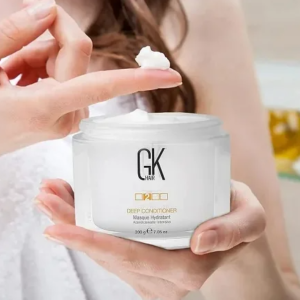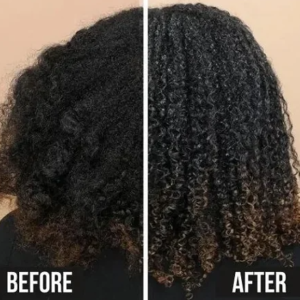When it comes to hair care, we usually think of hot oil treatments and deep treatments, both of which keep hair healthy and shiny by preventing breakage and friction, but do you know the difference between them? Or would you like to understand which one works better? In this article, we will tell you what hot oil treatment and deep conditioning are and which is better between them.
1. What Is Hot Oil Treatment For Hair?
 Hot oil treatment is the application of carrier oil or oil made from a variety of ingredients to the hair. These oils are heated because they need to be hot enough to penetrate deeply into the scalp. But don’t worry it won’t burn you. Hot oil hair treatments have a variety of benefits, and these benefits also vary depending on the type of oil you choose.
Hot oil treatment is the application of carrier oil or oil made from a variety of ingredients to the hair. These oils are heated because they need to be hot enough to penetrate deeply into the scalp. But don’t worry it won’t burn you. Hot oil hair treatments have a variety of benefits, and these benefits also vary depending on the type of oil you choose.
2. How To Do Hot Oil Treatment For Hair?
If you don’t know how to give your hair the hot oil treatment, now here are some steps to help you and you can follow step by step.

Step 1: Select the proper oil
Before starting a hot oil treatment for your hair, you need to choose the best oil for you based on your scalp and hair type. Coconut, jojoba, olive, and almond oils are commonly used in thermal oil treatment. Tips: If you have an oily scalp, opt for light oils such as olive and almond oils. However, if you have very dry hair, choose a thicker oil, such as coconut oil.
Step 2: Heat the oil
Heat the oil of your choice for a few seconds until it’s warm (but not hot).
Tips: Test the temperature on the handle before applying the oil to your hair.
Step 3: Apply the oil to your scalp
Apply the oil to the scalp and massage the scalp in small circles with your fingers.
Step 4: Use a wide-toothed comb
Once the oil is distributed throughout the scalp, use a wide-toothed comb to pull the product to the ends of the hair.
Step 5: Wait for 20-30 minutes
Cover your hair with a plastic shower cap and allow the oil to sit in your hair for 15 to 30 minutes.
Step 6: Rinse your hair
Finally, rinse off the oil with water. Shampoo and conditioner can also be used if desired.
3. What Is Deep Conditioning For Hair?
 Deep conditioning uses a DIY or over-the-counter deep conditioner on the scalp and hair, paired with steam or moist heat to boost the penetration of the formula into the hair. The aim is to recover dry, damaged hair by rebuilding the hair’s molecular layers and replenishing moisture, leading to thicker, softer, and more vibrant hair.
Deep conditioning uses a DIY or over-the-counter deep conditioner on the scalp and hair, paired with steam or moist heat to boost the penetration of the formula into the hair. The aim is to recover dry, damaged hair by rebuilding the hair’s molecular layers and replenishing moisture, leading to thicker, softer, and more vibrant hair.
4. How To Do Deep Conditioning For Hair?
 Step 1: Choose the right deep conditioner
Step 1: Choose the right deep conditioner
Before deep conditioning your hair, you need to choose the right deep conditioner or DIY hair mask according to your hair type. If you want to know how to do a DIY hair mask, you can read: Several DIY Hair Masks You Can Try At Home
Step 2: Wash your hair
As deep conditioning treatments work best when hair is clean, you need to wash your hair with warm water.
Step 3: Apply the deep conditioner to the hair
Carefully apply the deep conditioner to the hair shaft. If you want them to be evenly distributed throughout your hair, you can use a wide-toothed comb. Be careful not to get the product too close to the hair roots.
Step 4: Wait for about 30 minutes
Put on a shower cap or wrap your hair in a towel, and let the deep conditioner sit on your hair for about half an hour. Tips: Since different products come with different instructions, you can also follow the instructions that came with the product.
Step 5: Rinse your hair
Finally, wash your hair with cold water to close the hair cuticle. Let hair air dry for best results.
5. The Difference Between Hot Oil Treatment And Deep Conditioning
 Now that you know what hot oil treatments and deep conditioning for hair are, you must be wondering how they are different. Now, we will tell you one by one.
Now that you know what hot oil treatments and deep conditioning for hair are, you must be wondering how they are different. Now, we will tell you one by one.
5.1 Purpose
The hot oil treatment is mainly used on the scalp to allow the oil to penetrate deeply into the scalp, thereby protecting the hair and preventing damage. However, deep conditioning is suitable for hair shafts. It helps lock in moisture, and detangles and hydrates hair for shine.
5.2 Temperature
As the name implies, hot oil treatment involves heating the oil. However, the oil should not be heated to arbitrary temperatures as this may render the active ingredients ineffective. The heating should ideally be kept to around 65°, as this is the optimum temperature for activating the ingredients in the oil.
For deep conditioning, no heating or temperature control is required. However, some of the ingredients in deep conditioners may be too cold for some people and may cause excessive discomfort.
5.3 Ingredients
Hot oil treatment is done with a single oil or a mixture of oil extracts. Common ingredients are coconut oil, almond oil, olive oil, hibiscus, curry leaves, etc., which will not result in damage to the hair. While deep conditioners may contain chemicals that can be harmful to your hair, so read the directions carefully before using them.
5.4 Order of use
Hot oil treatment and deep conditioning occur at different stages of the hair care regimen. Usually, the hot oil treatment is carried out before washing, while deep conditioning is done after washing your hair when the scalp is free of excess oil and grime.
6. Hot Oil Treatment VS Deep Conditioning, Which Is Better For Your Hair?
 Hot oil treatments and deep conditioning support moisturizing hair, repairing damage, nourishing and restoring shine and smoothness. However, there is a distinction between hot oil treatment and deep conditioning. Although people keep arguing that one is better than the other, you can’t substitute one for the other.
Hot oil treatments and deep conditioning support moisturizing hair, repairing damage, nourishing and restoring shine and smoothness. However, there is a distinction between hot oil treatment and deep conditioning. Although people keep arguing that one is better than the other, you can’t substitute one for the other.
You can combine the two with a hot oil treatment before shampooing and deep conditioning after shampooing for healthier and shinier hair. But it should be noted that you only need to do it 1-2 times a week, not too many times, this will prevent your hair from being over-conditioning.



